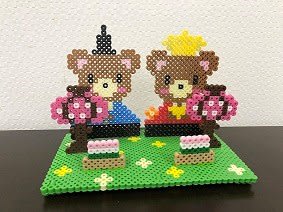もうすぐひな祭りです。それに合わせて、アイロンビーズでも飾りを作ってみました。
いい機会なのでひな祭りについても少し調べてみました。以下その内容です。
ひな祭りとは、女の子の節句とも呼ばれ、女子の健やかな成長を祈る節句の年中行事で日本においては特別な日である。毎年3月3日に執り行われる。ひな壇に赤い毛氈(もうせん)を敷きその上に平安時代の十二単を着た、内裏雛(だいりびな)、三人官女(さんにんかんじょ)、五人囃子(ごにんばやし)等のひな人形がそれぞれの位置に配置されている。
ひな祭りは中国暦における吉日に行われる五節句のひとつである。グレゴリオ暦が使用されるようになって以降、これらは1月1日、3月3日、5月5日、7月7日、9月9日となった。ひな祭りは桃の花が咲く季節に行われていたことから伝統的に桃の節句としても認知されている。グレゴリオ暦に変わってからも未だ桃がひな祭りのシンボルとなっている。
ひな祭りにおいて一番特徴的なのは平安時代の結婚式にみたて赤い布の上に男雛、女雛を飾るところである。シンプルなものだと絵やおりがみだけのものもある。手の込んだものになると立派なひな壇に十二単を着た男雛・女雛含め3段以上のものなどがある。全てのひな人形や飾り、これら全てを含めた1セットのことを雛盛り(ひなざかり)と呼ぶ。ひな壇の段数やひな人形の数はそれぞれの家庭で異なる。
雛盛りは1年の大半は倉庫にしまってあり、ひな祭りの数日前に女の子たちは母親と飾り付けを始める。伝統的に娘の結婚が遅れるという迷信からひな人形はひな祭りが終わるとすぐに片付けられるが、家庭によっては3月いっぱい飾っているところもある。歴史的にひな人形はおもちゃとして扱われていたが、現在は飾るのみとなっている。基本的に10歳になるとひな人形は飾られなくなる。
ひな祭りになると女の子たちは友だちとパーティを開く。そして、雛あられ、ちらし寿司、菱餅、いちご大福、うしお汁、白酒、甘酒などを食べたり飲んだりする。
流し雛と呼ばれる催しも全国各地で行われている。参加者は紙や藁を使いひな人形を作りそれを船に乗せ厄や罪と共に川に流すというものである。
調べれば調べるほど奥が深く全部をまとめることは難しいのですが、簡単にまとめてみました。こうしていつも当たり前の様に行っている行事を改めて見つめていくと新しい発見があり新鮮でした。

ぼんぼりがかわいいですね!
Hinamatsuri (雛祭り Hina-matsuri), also called Doll's Day or Girls' Day, is a special day in Japan. Celebrated each year on March 3rd, platforms covered with a red carpet-material are used to display a set of ornamental dolls (雛人形 hina-ningyō) representing the Emperor, Empress, attendants, and musicians in traditional court dress of the Heian period.
Hinamatsuri is one of the five seasonal festivals (五節句 go-sekku) that are held on auspicious dates of the Chinese calendar: the first day of the first month, the third day of the third month, and so on. After the adoption of the Gregorian calendar, these were fixed on 1 January, 3 March, 5 May, 7 July, and 9 September. The festival was traditionally known as the Peach Festival (桃の節句 Momo no Sekku), as peach trees typically began to flower around this time. Although this is no longer true since the shift to Gregorian dates, the name remains and peaches are still symbolic of the festival.
The primary aspect of Hinamatsuri is the display of seated male and female dolls (the obina (男雛) and mebina (女雛), literally "male doll" and "female doll" respectively, which represent a Heian period wedding. but usually described as the Emperor and Empress of Japan), usually on red cloth. These may be as simple as pictures or folded paper, or intricately carved three-dimensional dolls. More elaborate displays will include a multi-tiered doll stand (雛壇 hinadan) of dolls that represent ladies of the court, musicians, and other attendants, with all sorts of accoutrements. The entire set of dolls and accessories is called the hinazakari (雛盛り). The number of tiers and dolls a family may have depends on their budget.
The hinazakari spends of most of the year in storage, and girls and their mothers begin setting up the display a few days before 3 March. Traditionally, the dolls were supposed to be put away by the day after Hinamatsuri, the superstition being that leaving the dolls any longer will result in a late marriage for the daughter, but some families may leave them up for the entire month of March. Historically, the dolls were used as toys, but in modern times they are intended for display only. The display of dolls usually discontinues when the girls reach 10 years old.
During Hinamatsuri girls hold parties with their friends. Typical foods include hina-arare (雛あられ) (rice crackers), chirashizushi (ちらし寿司) (raw fish and vegetables on rice in a bowl or bento box), hishi mochi (菱餅) (multicolored rice cakes),[4] ichigo daifuku (いちご大福) (strawberries wrapped in adzuki bean paste), and ushiojiru (うしお汁) (clam soup, as clam shells represent a joined pair).[5] The customary drink is shirozake (白酒) (lit. "white sake"), also called amazake (甘酒) (lit. "sweet sake"), a non-alcoholic sake.
Nagashi-bina (流し雛, lit. "doll floating") ceremonies are held around the country, where participants make dolls out of paper or straw and send them on a boat down a river, carrying one's impurities and sin with them. Some locations, such as at the Nagashibina Doll Museum in Tottori City, still follow the lunisolar calendar instead of doing it on 3 March.
※Wikipediaより抜粋 (Sited from Wikipedia)


















